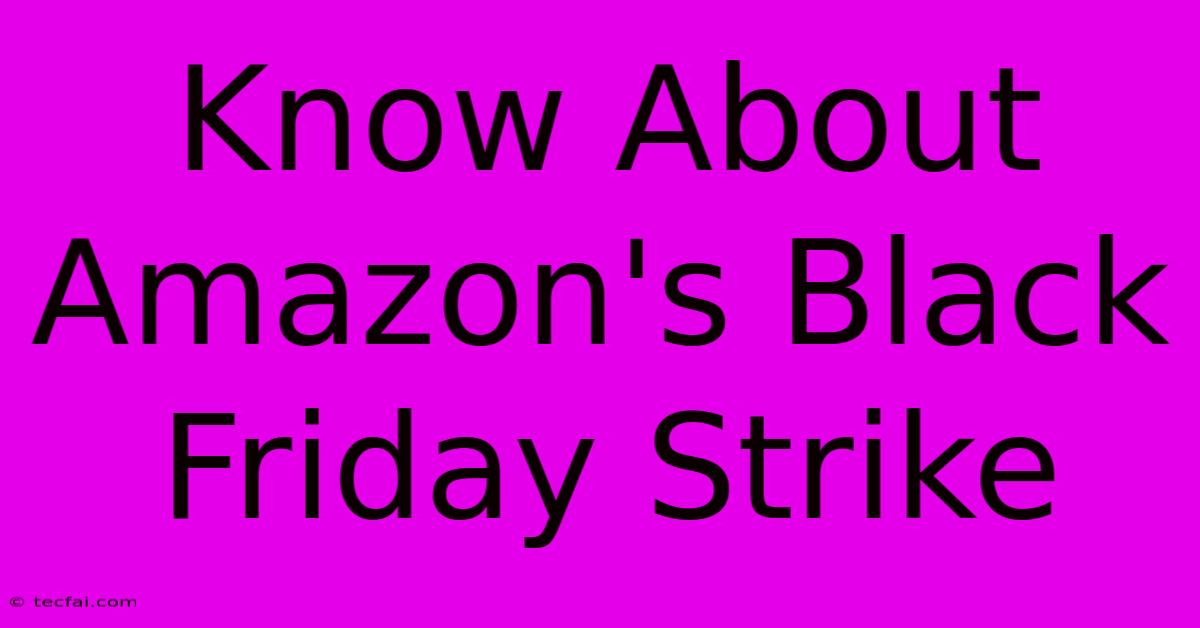Know About Amazon's Black Friday Strike

Discover more detailed and exciting information on our website. Click the link below to start your adventure: Visit Best Website tecfai.com. Don't miss out!
Table of Contents
Know About Amazon's Black Friday Strike: A Deeper Dive into Worker Concerns
Amazon, the undisputed king of e-commerce, is synonymous with Black Friday – a day of massive sales and record-breaking profits. However, behind the scenes of the frantic fulfillment and delivery operations, a different story unfolds. For several years, there's been growing unrest among Amazon workers, leading to strikes and protests, particularly around Black Friday. This article will delve into the reasons behind these actions, exploring the key concerns driving Amazon employees to take such a significant step.
Why Black Friday? A Perfect Storm of Pressure
Black Friday represents the culmination of immense pressure for Amazon workers. The already demanding year-round workload intensifies dramatically during this peak shopping season. Employees are expected to meet significantly higher quotas, often working extended hours with little to no extra compensation. This heightened pressure, coupled with the existing concerns about working conditions, creates a potent catalyst for protest.
Key Concerns Fueling the Amazon Black Friday Strikes
Several significant factors contribute to the unrest among Amazon employees, culminating in strikes during Black Friday:
-
Working Conditions: Reports consistently highlight concerns about the strenuous physical demands of the job, inadequate safety measures, and high injury rates within Amazon warehouses. The relentless pace and pressure to meet targets often lead to injuries and burnout.
-
Fair Wages and Benefits: Amazon's vast profits have fueled debate about the fairness of its compensation packages for its workforce. Many workers argue their wages are insufficient to meet the cost of living, especially considering the demanding nature of their jobs. Concerns also extend to benefits, such as healthcare and paid time off.
-
Lack of Union Representation: The absence of strong union representation in many Amazon facilities is a significant factor. Workers often feel they lack a collective voice to address their concerns effectively with management. This power imbalance contributes to their sense of frustration and fuels the desire for collective action.
-
Technological Control and Surveillance: Amazon's extensive use of technology to monitor worker performance, including metrics and surveillance, adds another layer of pressure and contributes to feelings of dehumanization. This constant monitoring can create a stressful and anxiety-inducing work environment.
The Impact of the Strikes on Amazon and Consumers
The Amazon Black Friday strikes have a multifaceted impact:
-
Disruption to Operations: Strikes can cause delays in order fulfillment and delivery, potentially impacting the shopping experience for consumers.
-
Public Attention to Worker Issues: The strikes raise public awareness of the working conditions and challenges faced by Amazon employees, putting pressure on the company to address these concerns.
-
Shift in Public Perception: Negative publicity surrounding the strikes could damage Amazon's brand image and affect consumer loyalty.
-
Negotiating Power for Workers: The collective action demonstrates the workers' determination to fight for better conditions and potentially increase their negotiating power with the company.
The Future of Amazon and its Workforce
The ongoing struggle between Amazon and its employees highlights the evolving dynamics of labor relations in the gig economy and within large-scale logistics companies. The future likely involves continued pressure from workers for improved working conditions, fair wages, and stronger union representation. Amazon's response to these concerns will play a crucial role in shaping the future of its workforce and its reputation. The Black Friday strikes serve as a critical reminder of the human cost behind the convenience and efficiency of online shopping. Understanding these issues is crucial for consumers, investors, and the broader public as we continue to navigate the complexities of the modern economy.

Thank you for visiting our website wich cover about Know About Amazon's Black Friday Strike. We hope the information provided has been useful to you. Feel free to contact us if you have any questions or need further assistance. See you next time and dont miss to bookmark.
Featured Posts
-
Deutsche Bank On Hertz Higher Price Target
Nov 30, 2024
-
Taylor Swift Donna Kelce At Game
Nov 30, 2024
-
Goldies Masterpiece Auction Details
Nov 30, 2024
-
Musician Bob Bryar Found Deceased
Nov 30, 2024
-
Inside Notre Dames Restoration
Nov 30, 2024
